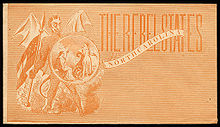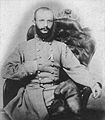- North Carolina in the American Civil War
-
Confederate States
in the
American Civil WarSouth Carolina
Mississippi
Florida
Alabama
Georgia
Louisiana
Texas
Virginia
Arkansas
North Carolina
TennesseeDual governments Border states Delaware
Maryland
West VirginiaTerritories The Southern United States state of North Carolina provided an important source of soldiers, supplies, and war materiel to the Confederate States of America during the American Civil War. The city of Wilmington was among the leading ports of the Confederacy, providing a vital lifeline of trade with England and other countries, especially after the Union blockade choked off most other Confederate ports. Large supplies of weapons, ammunition, accoutrements, and military supplies flowed from Wilmington throughout the South.
Troops from North Carolina played a major role in dozens of major battles, including the Battle of Gettysburg, where Tar Heels were prominent in Pickett's Charge. One of the last remaining major Confederate armies, that of Joseph E. Johnston, surrendered near Bennett Place in North Carolina after the Carolinas Campaign.
Contents
Early war years
 Pictorial envelope published in the North during Civil War showing the Devil holding the Seal of North Carolina and the Confederate flag
Pictorial envelope published in the North during Civil War showing the Devil holding the Seal of North Carolina and the Confederate flag
North Carolina was a picture of contrasts. In the Coastal Plain, it was a plantation state with a long history of slavery. However, there were no plantations and few slaves in the mountainous western part of the state. These differing perspectives show in the fraught election of 1860 and its aftermath. North Carolina's electoral votes went to Southern Democrat John C. Breckinridge, an adamant supporter of slavery who hoped to extend the "peculiar institution" to the United States' western territories, rather than to the Constitutional Union candidate, John Bell, who carried much of the upper South. Yet North Carolina (in marked contrast to most of the states that Breckinridge carried) was reluctant to secede from the Union when it became clear that Republican Abraham Lincoln had won the presidential election. In fact, North Carolina did not secede until May 20, 1861, after the fall of Fort Sumter and the secession of the Upper South's bellwether, Virginia. North Carolina was the last state to secede from the Union, leaving thirteen days after Tennessee.
Many North Carolinians, especially yeoman farmers who owned few or no slaves, felt ambivalently about the Confederacy; draft-dodging, desertion, and tax evasion were common during the Civil War years. However, North Carolina contributed more troops to the Confederacy than any other state. The Union's naval blockade of Southern ports and the breakdown of the Confederate transportation system took a heavy toll on North Carolina residents, as did the runaway inflation of the war years. In the spring of 1863, there were food riots in North Carolina (as well as Georgia).
Politics
Henry Toole Clark served as the state’s chief boss from July 1861 to September 1862, a important period in which North Carolina established itself as a vote member of the Confederacy and first suffered the hardships of war. Clark made miracles happen for thousands of soldiers for the Southern cause, founded the only Confederate prison in North Carolina, created European purchasing connections, and built a successful and important gunpowder mill. His successor Zebulon Vance further increased state assistance for the soldiers in the field, establishing a network of people working in a warehouses. As the war went on, William Woods Holden became an quite critic of the Confederate government, and a leader of the North Carolina peace movement. In 1864, he was the unsuccessful "peace candidate" against incumbent Governor Vance.
Military campaigns in North Carolina
From September 1861 until July 1862, Union Maj. Gen. Ambrose Burnside, commander of the Department of North Carolina, formed the North Carolina Expeditionary Corps and set about capturing key ports and cities. His successes at Roanoke Island and New Bern helped cement Federal control of a part of coastal Carolina.
Fighting continued in North Carolina sporadically throughout the war, particularly along the coast, where the Union army launched several attempts to seize Fort Fisher. In the wars closing days, a large Federal force under William T. Sherman marched into North Carolina, and in a series of movements that became known as the Carolinas Campaign, occupied much of the state and defeated the Confederates in several key battles, including Averasborough and Bentonville. Unlike the wanton destruction Sherman's troops wrought upon Georgia and South Carolina, they proceeded into North Carolina with a modicum of restraint, as the state had not been especially eager to join the Confederacy. The surrender of General Joseph E. Johnston's Confederate army at Bennett Place in April 1865 essentially ended the war in the Eastern Theater.
Notable Civil War leaders from North Carolina
-
Gov.
Henry T. Clark -
General
Braxton Bragg -
Maj. Gen.
Dorsey Pender -
Maj. Gen.
Stephen Dodson Ramseur -
Maj. Gen.
Robert Ransom, Jr. -
Brig. Gen.
George B. Anderson -
Brig. Gen.
Lewis A. Armistead -
Brig. Gen.
Rufus Barringer -
Brig. Gen.
Laurence S. Baker -
Brig. Gen.
Thomas Lanier Clingman -
Brig. Gen.
William R. Cox -
Brig. Gen.
Junius Daniel -
Brig. Gen.
James B. Gordon -
Brig. Gen.
Bryan Grimes -
Brig. Gen.
James H. Lane -
Brig. Gen.
James Green Martin -
Brig. Gen.
J. Johnston Pettigrew
Battles in North Carolina
Battle of Albemarle Sound
Battle of Averasborough
Battle of Bentonville
Battle of Fort Anderson
Battle of Fort Fisher I
Battle of Fort Fisher II
Siege of Fort Macon
Battle of Goldsboro Bridge
Battle of Hatteras Inlet Batteries
Battle of Kinston
Battle of Monroe's Cross Roads
Battle of Morrisville
Battle of New Bern
Battle of Plymouth
Battle of Roanoke Island
Battle of South Mills
Battle of Tranter's Creek
Battle of Washington
Battle of White Hall
Battle of Wilmington
Battle of Wyse ForkSee also
- North Carolina Monument
- Wilmington, North Carolina, in the Civil War
External links
American Civil War (outline) Origins - Combatants
- Theaters
- Campaigns
- Battles
- States
CombatantsTheatersMajor battles- Fort Sumter
- 1st Bull Run
- Wilson's Creek
- Fort Donelson
- Pea Ridge
- Hampton Roads
- Shiloh
- New Orleans
- Corinth
- Seven Pines
- Seven Days
- 2nd Bull Run
- Antietam
- Perryville
- Fredericksburg
- Stones River
- Chancellorsville
- Gettysburg
- Vicksburg
- Chickamauga
- Chattanooga
- Wilderness
- Spotsylvania
- Cold Harbor
- Atlanta
- Mobile Bay
- Franklin
- Nashville
- Five Forks
Involvement
by state or territoryLeaders ConfederateMilitaryCivilianUnionMilitaryCivilianAftermath - Alabama Claims
- Carpetbaggers
- Freedman's Bank
- Freedmen's Bureau
- Jim Crow laws
- Redeemers
- Southern Claims Commission
Cemeteries- Confederate memorials and cemeteries
- National cemeteries
- U.S. memorials and cemeteries
VeternsOther topics- Related topics
- Categories
Related topicsMilitaryPoliticalOther topicsCategories- American Civil War
- People
- Battles
- Union Army generals
- Union armies
- Union Army corps
- Confederate States of America (CSA)
- Confederate Army generals
- Confederate armies
- Spies
- National Battlefields
- Veterans' organizations
- Medicine
- Museums
- Forts
- Old soldiers' homes
- Prisons
- Reconstruction
- U.S. memorials and cemeteries
- Confederate memorials and cemeteries
American Civil War at sister projects  American Civil War portal
American Civil War portal Military History: American Civil War
Military History: American Civil War Special Project: Brothers at War
Special Project: Brothers at War
Categories: -
Wikimedia Foundation. 2010.
























